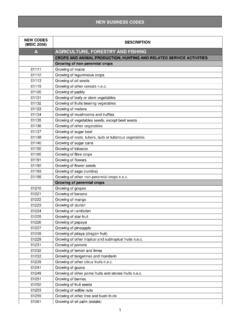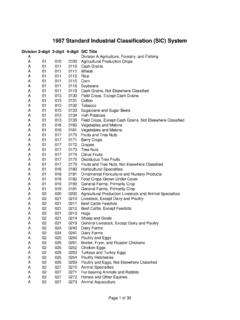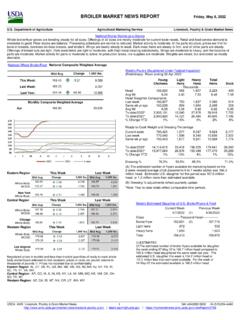Transcription of BROILER FEEDING - Epol
1 BROILER FEEDING1 GETTING READY Everything must be ready in the rearing house before the day old chicks arrive on the farm. Make sure you have planned your vaccination FEEDING POINTS The starter feed must be in crumble form. The feed for the subsequent phases should be in pellet form. The amount of feed per bird is just an indication. broilers should never be without feed. From day 2, feed should also be put in the FEEDING troughs so that chicks can learn to eat from it. Do not place feed or water directly under the heat source as this may cause the chicks to eat or drink less than they should.
2 Select the most appropriate Epol BROILER feed to suit your requirements from page 5, or speak to an Epol Technical CONDITIONS The house should be clean and thoroughly sanitized using appropriate disinfectants. Prior to placing chicks, put the bedding material in as follows:CHECK FEEDING EQUIPMENT Make sure that there are enough drinkers and feeders for the number of chicks ordered. See below table for TYPEMINIMUM DEPTH OR VOLUMEWood cmDry cmChopped straw1 kg/m2 Sunflower hulls5 cmTYPEQUANTITYDRINKERBellNipple1 per 100 birds12 birds per nippleFEEDERPan Tube45 birds per pan70 birds per 40 cm tube feeder2 CHECK HEATING EQUIPMENT Make sure that heaters or brooders are in a good working condition and at the correct height.
3 Temperature management is essential for the successful rearing of chickens, so make sure that you have a thermostat to measure and record minimum and maximum temperatures in the chicken house. Start heating the house 2 days before the chicks arrive. Feed and water must be in the house a day before so that it is at room temperature when the chicks arrive. The floor temperature must be 32 C at placement. The temperature of the rearing house should be carefully regulated especially for the first 14 THE CHICKS The chicks should be gently placed on the litter, and there should be water and feed available.
4 Use paper to cover 50% of the brooding area, there must be 50 - 70 grams of feed per chick. Weigh some of your day old chicks and record their starting weight on your house card for performance tracking CHECKS The first chick check should be done 4 to 6 hours after placement. Young chicks should be eating, drinking and running around - if not, ask yourself why? Feel the chick s feet on your cheek or neck. If the feet are cold, then the chick is cold. If the floor is cold, it could be because the pre-heating of the brooding area was not done sufficiently or early enough.
5 Chick behaviour is the best indicator of correct temperature so observe how the chicks spread out in the brooding cold Chicks crowd towards brooder. Chicks noisy, temperature Chicks evenly spread. Noise level signifies hot Chicks make no noise. Chicks pant, head and wings droop. Chicks keep away from investigation Check for a draught, uneven light distribution or external The second chick check should be a day after placement. The crops of chicks should be checked (crop scoring) the next morning to ensure they have located feed and water.
6 At this time a minimum of 95% of the crops should feel soft and elastic, indicating chicks have successfully found feed and water. Hard crops show that chicks have not consumed enough water, and water availability should be checked immediately. Swollen crops indicate chicks have consumed enough water but have not fed sufficiently. In this case, the availability and quality (smell, taste) of the feed should be immediately evaluated. At 7 days, the weight of the chicks should ideally be more than 4 times their starting weight.
7 If chicks have not grown to this extent you should investigate the cause. Evaluate the process to date, include temperature, feed intake, water intake and other environmental conditions. If you need help in this regard contact your local technical advisor who will guide you. Everyday checks should also be conducted. When entering a house, always do so as quietly as possible so as not to disturb the birds. Immediately upon entering the house use all of your senses to evaluate if something is not ideal. Look, smell, feel and listen.
8 After a few minutes, your body adjusts to the environment and you won t be able to smell or feel what s wrong. Make sure that the temperature in the house is correct using this table as a (Days)RELATIVE HUMIDITY (%)TEMPERATURE (0C)030 - 5032 - 38740 - 6029 - 301450 - 6027 - 282150 - 6024 - 262850 - 6521 - 233550 - 7019 - 214250 - 7018 CROP Check if there are cold spots and/or draughts in the house. Check if the ventilation is correct. Check if the drinkers and feeders are at the correct height and if there is enough of them for the number of birds.
9 Check the bedding, it shouldn t be too wet or too dry. Remove all the dead birds and record on the house PROGRAMME Lighting is an important factor to get good performance from the POINTS TO MEASURE THROUGHOUT THE CYCLE: Chicks day-old weight. Weights at day 7, 14, 21, 28 and 35. When and how many birds died. Amount of feed that is used. Amount of water that is used. Minimum and maximum temperatures. Any treatment or medication given to the (Days)HOURS (Dark)0011 Chicks between 100 160 grams92282372465 days before slaughter54 days before slaughter43 days before slaughter32 days before slaughter21 day before slaughter15 EPOL BROILER FEED RANGESEpol offers a wide selection of BROILER feeds to suit the specific needs of different BROILER farmers.
10 RECOMMENDED FEED TABLE PER RANGE PER CHICK:RANGESUITABLE FORPRE STARTERSTARTERGROWERFINISHERPOST FINISHERE conoFor the smaller producer who sells live broilers to the market. It is a cost-effective range with a moderate growth *0 - 1516 - 2526 - 365 days < slaughterV - No.*15433222291552715432 Grams*800 g1 kg700 gOptigroAvailable in a 3 or a 5 phase diet, the slightly lower energy levels make this ration the economic alternative to the Higro range. This ration is designed for the producer who wants to grow a bigger bird over a longer time, this feed will provide the optimum - 910 - 1516 - 2526 - 365 days < slaughterV - / 6721543015429 / 1552615428 / 1201 Grams200 g400 g1 kg600 gHigroThe premium diet in the Epol range of BROILER feeds.






